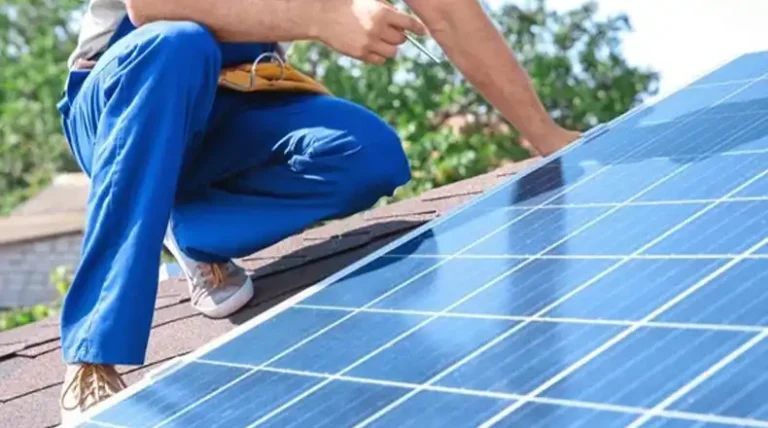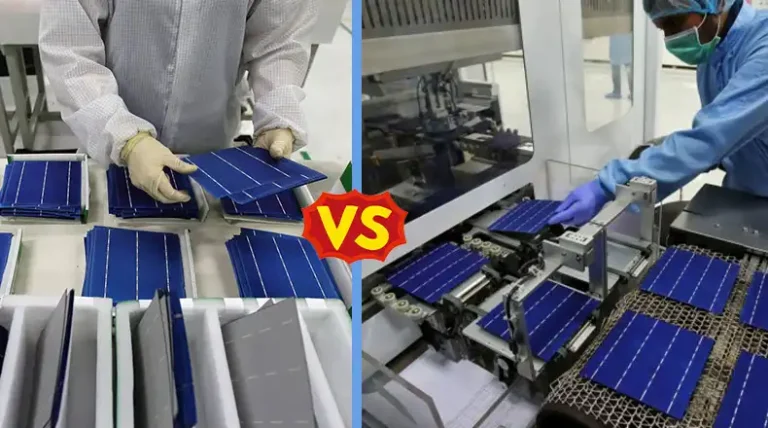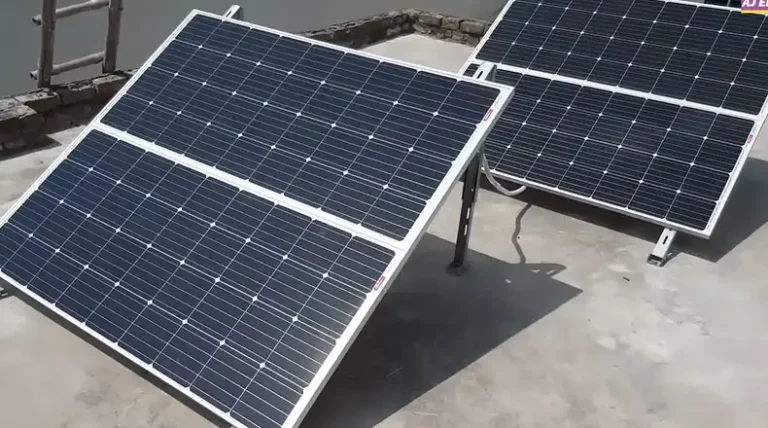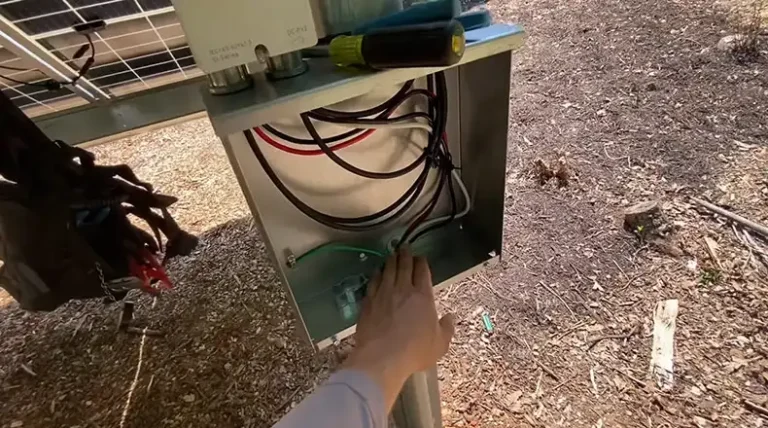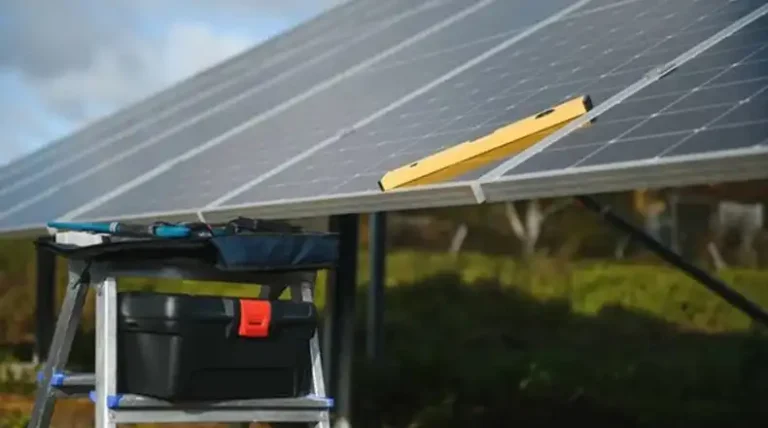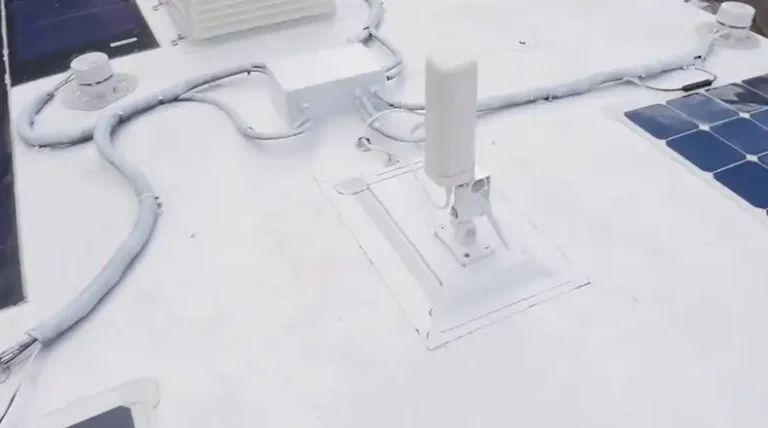Community Solar Vs Rooftop Solar | How I Apart Them
With climate change accelerating and electricity rates fluctuating, solar energy has become an increasingly attractive option for many homeowners and organizations. Solar panel installations have skyrocketed over the last decade, projected to quadruple globally between 2018 and 2024. However, deciding between a community solar farm or rooftop solar panels can be confusing.
Community solar and rooftop solar share similarities – they both harness energy from the sun and reduce fossil fuel dependence. However, key differences separate their functionality, costs, and benefits.
This article will compare community solar versus rooftop panels across critical categories like the key differences, pros and cons, costs, affordability, electricity production, installation obstacles, and ideal consumer profiles. Let’s explore the differences and similarities between community solar and rooftop solar to help you determine which option is best for your home or organization.
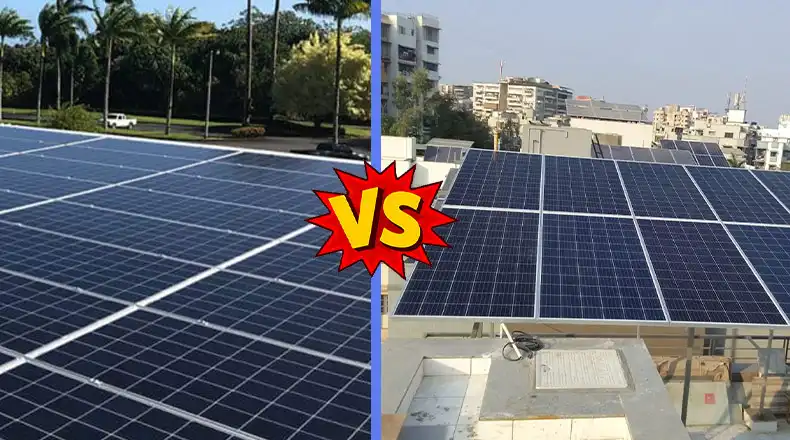
What is Community Solar?
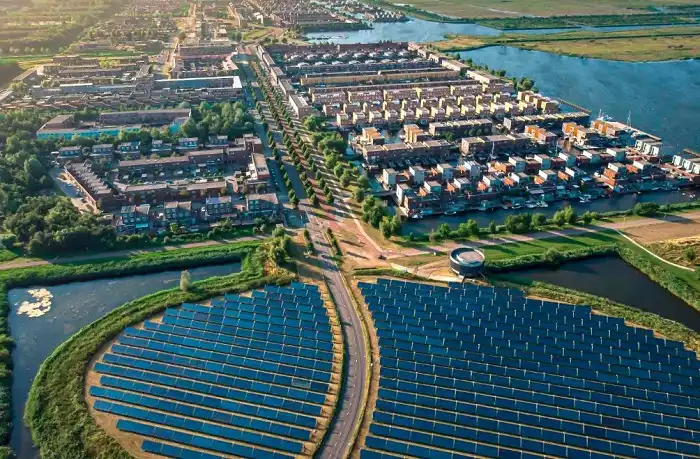
Community solar, also called shared solar or solar farms, consists of an offsite, large-scale array of solar panels. Community subscribers, including homeowners, renters, and businesses, can purchase or lease portions of the solar farm to receive credits that reduce their utility bills. This virtual net metering model allows consumers to switch partially or entirely to solar energy without dealing with solar panel maintenance, adjustments, or rooftop obstacles. Over 1.9 gigawatts of community solar capacity is now installed nationally.
Benefits of Community Solar
The advantages of joining a community solar program include:
- Affordability – Subscriptions cost less upfront than purchasing rooftop solar panels.
- No rooftop or property needed – Renters and apartment dwellers can utilize solar.
- Minimal responsibility – Low involvement once subscribed as the solar farm handles system maintenance.
- Easy to switch or cancel – Shorter contract terms than rooftop panels and cancellation flexibility.
- Scalable – Community options from just a few panels to meet 100% of usage.
- Eligible – Universal eligibility regardless of roof or renting situation.
- Electricity Bill Reduction – Provides partial clean energy bill reductions.
Although community solar has a lot of benefits, there are also some drawbacks:
Community Solar Drawbacks
- Provides smaller 20% bill reductions compared to rooftop potential.
- Property transfers can complicate community subscription access.
- Limited capacity for homeowners with adequate rooftop space.
- No long-term asset value since production is subscription-based.
What are Rooftop Solar Panels?
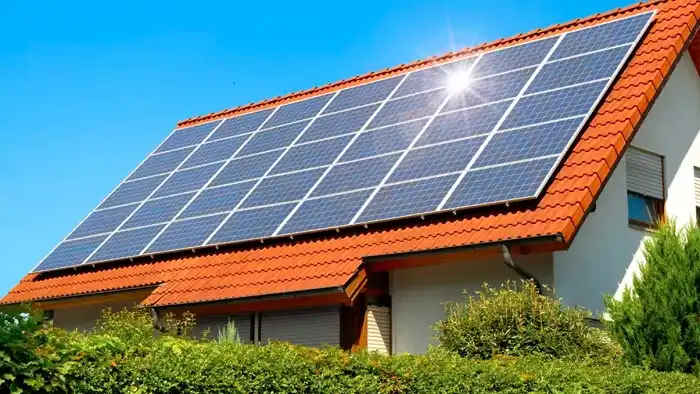
Rooftop solar photovoltaic (PV) systems consist of solar panels professionally mounted onto home or business rooftops. The solar array converts sunlight into direct current electricity. This charges batteries or runs back into the building’s electrical system to power lighting, appliances, and devices. Meanwhile, any excess solar energy gets fed back into the regional utility grid. This earns homeowners credits via net metering programs.
Benefits of Roof Top Solar
People choose to install rooftop solar panels to reduce electricity bills, increase home values, achieve energy independence, and benefit the environment. Rooftop solar advantages include:
- Personalization – Tailor the system to match specific energy usage according to your household energy usage.
- Owning the array – Long-term investment with system ownership. With rooftop panels, solar investment stays with the house.
- Increased home value – Panels add 4.1% value on average nationally. It is a clean energy production tied directly to property values.
- Energy independence – It reduces grid dependence and weather event impacts while providing full energy independence and 100% solar offset potential.
- Battery integration – It provides greater grid independence and outage resilience. You can store solar energy for nighttime usage.
Despite the above benefits, rooftop solar also has some disadvantages,
Rooftop Solar Drawbacks
- High upfront installation costs of $15,000+.
- 20+ year contract locks to property infrastructure.
- Rooftop shade, age or ownership issues can obstruct installs.
- Requires homeowner system monitoring and maintenance.
- Difficult to transfer electricity production during moves.
Now that we’ve covered the basics of both solar solutions, let’s analyze how they compare across critical factors:
The Differences Between Community Solar and Rooftop Solar
Here are the key differences between Community Solar and Rooftop Solar:
| Factor | Community Solar | Rooftop Solar |
| Location | Large-scale rural solar farms. Personal space isn’t required. | Solar panels are installed directly on building rooftops. Personal space is required. |
| Upfront Cost | Little to none | $15,000+ average initial installation cost |
| Payments | $10 per panel per month | 20+ years of system payments |
| Contracts | Flexible, exit anytime | 20-year lifespan locks to property |
| Energy Production | Up to 20% of home usage | Tailored to offset up to 100% of usage |
| Ownership | Subscription-based | The owner owns the rooftop system |
| Maintenance | Handled by a community provider. So, you don’t have to worry about it. | It’s the homeowner’s responsibility to keep the system working and bear all the maintenance costs. |
| Customer Base | Renters, unsuitable roofs | Homeowners and building owners |
| Grid Support | Feeds into grid | Can provide grid or off-grid power |
| Resilience | Depends on grid stability | Increased independence from outages |
| Efficiency Over Time | Consistent | Degrades annually ~0.5% |
According to the above table, community solar utilizes large-scale rural solar farms while rooftop panels are mounted directly on home/building roofs. While community solar requires little to no money down, rooftop solar averages $15,000+ in install costs. Rooftop solar enables 100% self-consumption while the community shares electricity across subscribers, reducing bills by ~20%.
Let’s explore the comparisons between the two types of solar systems more in detail below:
Affordability and Costs
Affordability is one of the most influential aspects for homeowners and organizations determining whether to adopt solar power. Installing a complete rooftop solar array averages between $15,000 – $25,000 nationally after tax credits, with individual quotes varying based on system size, panels, location, and more. On the other hand, community solar subscriptions typically require little to no money down, with monthly payment plans starting around $10 per panel. This increased financial flexibility gives community options a pricing advantage over rooftop installs.
| Investment | Rooftop Solar | Community Solar |
| Upfront Cost | $15,000+ | $0 |
| Cost per Watt | $2.50 to $3.50 | $0.08 to $0.15 |
| Payback Period | 8 to 12 Years | None |
Additionally, joining a solar farm often takes just minutes online and requires shorter contract lengths – some programs allow customers to cancel at any time. So community solar offers lower financial risk and commitment than rooftop panels with 20-year lifespans. Of course, those who lease or finance rooftop systems mitigate upfront expenses too. Ultimately every household and building has a unique budget and cash flow considerations when weighing affordability.
Electricity Production Capacity
When deciding between shared or rooftop solar, electricity output is another key comparison. Well-designed rooftop solar arrays tailored specifically to a home or facility’s energy demand can achieve nearly 100% solar offset, reducing grid dependence. This gives homeowners greater energy independence and resilience to outages. Rooftop production also exceeds community options, with the average system ranging from 5 to 15 kW capacity.
In contrast, community solar farms divide electricity production across all subscribers. Although solar farms scale to the multi-megawatt range, individuals typically purchase just a few panels, limiting energy bill reductions to about 20%. So while convenient for subsidizing usage, joining a shared array won’t completely zero out bills. The chart below summarizes solar output differences:
| System Size | Rooftop Solar | Community Solar |
| Average Capacity | 5 to 15 kilowatts | 2 to 4 kilowatts |
| Percent Offset | 0 to 100% | 0 to 20% |
| Solar Credits | Excess purchased by the utility | Limited excess value |
Ultimately rooftop solar enables greater energy independence and production. But community options still lower carbon emissions and supplement households with clean, renewable energy.
Installation Obstacles
Installing a rooftop solar array requires assessing dozens of site-specific structural and spatial variables. Professional site evaluations help determine rooftop solar feasibility by inspecting:
- Rooftop age, expected longevity, and warranties
- Placement spacing, square footage, and angle
- Shading elements like chimneys and trees
- Electrical box, conduit, and wiring compatibility
Rooftops with extensive shading, aging infrastructure, or inadequate space often obstruct solar. Additionally, grids without updated net metering policies reduce financial incentives. These hurdles mean roughly 25% of U.S. buildings aren’t suitable for rooftop solar altogether.
Community solar circumvents many cumbersome rooftop requirements. Since large-scale solar farms occupy rural land lacking shade or spatial constraints, subscribers join knowing projects met installation feasibility. Community options also avoid altering home structures or electrical systems. So households and organizations lacking adequate rooftop conditions can still access solar energy.
Property Ownership Limitations
One standout benefit of shared solar is expanding renewable access to renters and apartment dwellers. The 49% of households renting can’t physically install rooftop panels. But by subscribing to portions of community solar farms, these demographics access the same perks like slashing energy bills and reducing carbon footprints. Relocating also proves easier since transferring or exiting community solar subscriptions is simpler than home solar investments.
For homeowners deciding between solar options, know rooftop arrays increase home values about 4.1% on average – recuperating about $15,000 at resale in many cases. So while community subscriptions don’t physically tie into properties, rooftop systems offer homeowners greater long-term, financial incentives.
Which Solar Energy Option is Right for You?
Ultimately solar energy, whether community or rooftop, makes progress towards renewable energy adoption. Assess individual household constraints, budgets, and solar goals to determine the ideal local solar solution. Layering shared and rooftop subscriptions can maximize benefits too.
Here is which option is right for whom:
Community solar works best for:
- Renters and apartment dwellers
- Homeowners with unsuitable rooftops
- Supplementary solar subscribers focused on lowering bills
Rooftop solar works best for:
- Building owners with adequate roof capacity
- Eco-focused households wanting maximum solar energy production
- Organizations pursuing net zero operations or resilience
Conclusion
Transitioning to solar power constitutes a complex decision with long-term grid, financial, and climate implications. While community solar offers subscription-based convenience and rooftop panels enable personalized production, both technologies advance renewable energy adoption. As the options expand from state to state in parallel with awareness and policy reform, consumers face promising opportunities to harness their local solar resources. Hopefully, this guide helped you compare community-shared solar versus rooftop photovoltaic arrays successfully. Please leave a comment with any other questions! Thanks for reading.
Questions and Answers
Can I Be Denied Joining A Community Solar Program?
Some programs have approval processes involving credit checks or income qualifications. However, most community solar projects welcome all community subscribers regardless of credit score or homeownership status.
What Happens If I Move Houses?
Relocating homes requires canceling a rooftop solar subscription and likely forfeiting any system investments or savings. With community solar, customers can seamlessly transfer subscriptions or point credits to new houses and properties.
Do I Need A New Roof To Install Solar?
Solar panels typically last 25+ years, so ideal roofs have at least 20 years of useful life remaining. However, solar can be installed on existing rooftops of any age, just with lower energy production over time as infrastructure ages.
Can Community And Rooftop Solar Power Each Other?
Absolutely! Layering both shared and rooftop systems maximizes renewable energy usage for households. Community solar slashes electricity costs on the net while rooftop panels drive towards full energy independence.
What Maintenance Do Solar Panels Require?
Community Solar handles all farm maintenance, upgrades, and repairs on behalf of subscribers. Rooftop solar owners should wipe down panels, check wiring, trim shading trees, and confirm system functionality annually. Professional cleanings help too.

